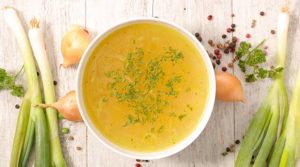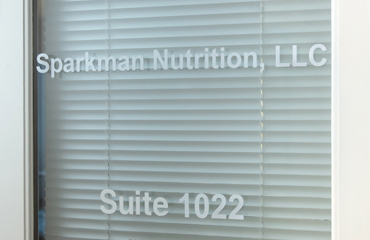By Anna Marie Oglesbee, CPD UT Austin with Alexa Sparkman MA, RDN, LD
Bone broth is made by boiling then slow simmering animal bones and connective tissue for at least 10 hours with herbs, vegetables, and spices. Because of all of the perceived benefits of bone broth, it has been nicknamed “liquid gold.”5 These benefits include approving the appearance of skin, relieving joint pain, soothing an inflamed digestive tract, and maintaining bone density.1 How could something so simple have so many benefits? Usually, if something sounds too good to be true, it is.
Bone broth manufacturers claim that ingesting type II collagen can improve the appearance of skin.1 The only way the skin can be improved with collagen is through production of collagen through consuming fruits and vegetables. Red and green vegetables high in lutein and lycopene act as antioxidants which promote collagen production in the body.3 Pure collagen consumed in the diet does not transform directly into collagen in the body. Fruits high in Vitamin C (citrus fruits) can also stimulate collagen production. Consuming a balanced diet high in fruits, vegetables, and adequate protein can stimulate collagen production without using bone broth.
Lots of products claim they support joint pain and wound healing, so it is hard to discern fact vs. fiction. There are nine essential amino acids that the body must acquire from protein in the diet to carry out normal bodily functions. Under times of catabolic stress, amino acids that are normally non-essential (the body can manufacture on its own) become essential (i.e. the body loses its ability to make these amino acids, so we must consume them). Catabolic stress is when metabolism is working harder than usual to maintain normal bodily functions. Examples of conditions that would induce catabolic stress include but are not limited to cancer, GI issues, burns, sepsis, and severe injury/surgery. Arginine and glutamine are two amino acids that are normally manufactured in the body, but under these conditions, they become conditionally essential. Bone broth is high in the amino acids proline and glycine.2 Both proline and glycine are non-essential amino acids. It’s great if these amino acids are consumed in the diet, but if not enough is consumed, the body can manufacture what is needed. Some research has shown that proline and glycine are conditionally essential in times of catabolic stress, but further research is needed to prove they are as important as arginine and glutamine.
Gelatin content of bone broth is high, and research has shown that gelatin can help soothe an inflamed GI tract.2 This research states that gelatin as well as other substances can help with inflammatory disease, but most research is done only on mice.6 Gelatin is derived from animal bones, skin, and tendons. Gelatin is found in bone broth as well as most dairy products, and some gummy candies. If increasing gelatin intake to soothe the GI tract is a goal, bone broth is not the only source of gelatin.
Manufacturers state the type II collagen in bone broth helps improve bone density.1 However, type I collagen as well as many other dietary contributors such as hydroxyapatite and water have been proven to improve bone density and strength and decrease osteoporosis risk.7 There are many types of collagen but the most prevalent are types I, II, III and IV.8,9 Type I collagen is found throughout the body in skin, tendons, organs, and bones. This type makes up about 90% of the collagen in the body. Type II is the main collagenous portion of cartilage. Type III is typically found alongside type I in the walls of arteries and other hollow organs. Type IV is found in cell membranes. Since the different types have different functions in the body, claiming that one type does what another type has been scientifically proven to do is false advertisement. As mentioned previously, the human body does not absorb collagen whole but rather manufactures it through consumption of antioxidants in fruits and vegetables. According to William Percy, an associate professor at University of South Dakota’s Sanford School of Medicine, “Since we don’t absorb collagen whole, the idea that eating collagen somehow promotes bone growth is just wishful thinking” (Blaszyk, 2015).4
Overall, the research is inconclusive about the actual benefits of consuming bone broth. Bone broth does contain type II collagen and gelatin, so if it is something that you enjoy, there is no reason to stop consuming it. However, most of the health claims for bone broth can be contradicted with a review of the literature. If you want a cure-all to improve the appearance of skin, relieve joint pain, soothe an inflamed digestive tract, and maintain bone density, bone broth is not the answer. A balanced diet with 4-5 servings of fruits and vegetables a day and high in whole grains and lean protein is a lot more beneficial than drinking bone broth and hoping for a “miracle cure”.
References:
- What is Bone Broth? (2018). Retrieved June 25, 2018, from https://www.kettleandfire.com/pages/what-is-bone-broth
- Daniel, K. (2003, June 18). Why Broth is Beautiful: Essential Roles for Proline, Glycine and Gelatin. Retrieved June 25, 2018, from https://www.westonaprice.org/health-topics/why-broth-is-beautiful-essential-roles-for-proline-glycine-and-gelatin/
- V. (2009, January 13). How to Increase Collagen By Eating the Right Foods – Skin Care | HealthCentral. Retrieved June 25, 2018, from https://www.healthcentral.com/article/how-to-increase-collagen-by-eating-the-right-foods
- Blaszyk, A. (2015, February 10). Taking Stock Of Bone Broth: Sorry, No Cure-All Here. Retrieved June 25, 2018, from https://www.npr.org/sections/thesalt/2015/02/10/384948585/taking-stock-of-bone-broth-sorry-no-cure-all-here
- Research Shows That Bone Broth is Liquid Gold (And Here’s Why). (2018, February 07). Retrieved June 25, 2018, from https://www.perfectketo.com/keto-bone-broth/#1
- Okazaki, K., Nakase, H., Watanabe, N., Tabata, Y., Ikada, Y., & Chiba, T. (2002). Intestinal drug delivery systems with biodegradable microspheres targeting mucosal immune-regulating cells for chronic inflammatory colitis. Journal of Gastroenterology,37(S14), 44-52. doi:10.1007/bf03326413
- Fonseca, H., Moreira-Gonçalves, D., Coriolano, H. A., & Duarte, J. A. (2014). Bone Quality: The Determinants of Bone Strength and Fragility. Sports Medicine,44(1), 37-53. doi:10.1007/s40279-013-0100-7
- Wu M, Crane JS. Biochemistry, Collagen Synthesis. [Updated 2018 Jun 2]. In: StatPearls [Internet]. Treasure Island (FL): StatPearls Publishing; 2018 Jan-. Available from: https://www-ncbi-nlm-nih-gov.ezproxy.lib.utexas.edu/books/NBK507709/
- Mandal, A. (2013, July 15). Collagen Types and Linked Disorders. Retrieved June 27, 2018, from https://www.news-medical.net/health/Collagen-Types-and-Linked-Disorders.aspx



